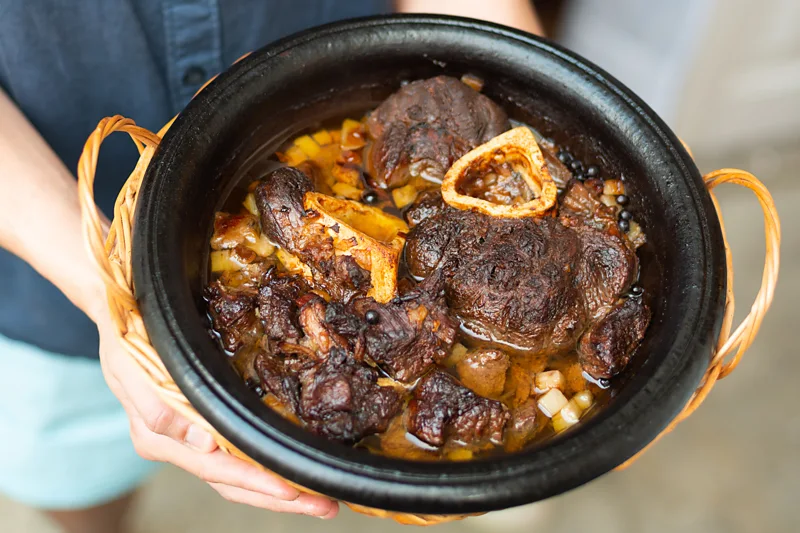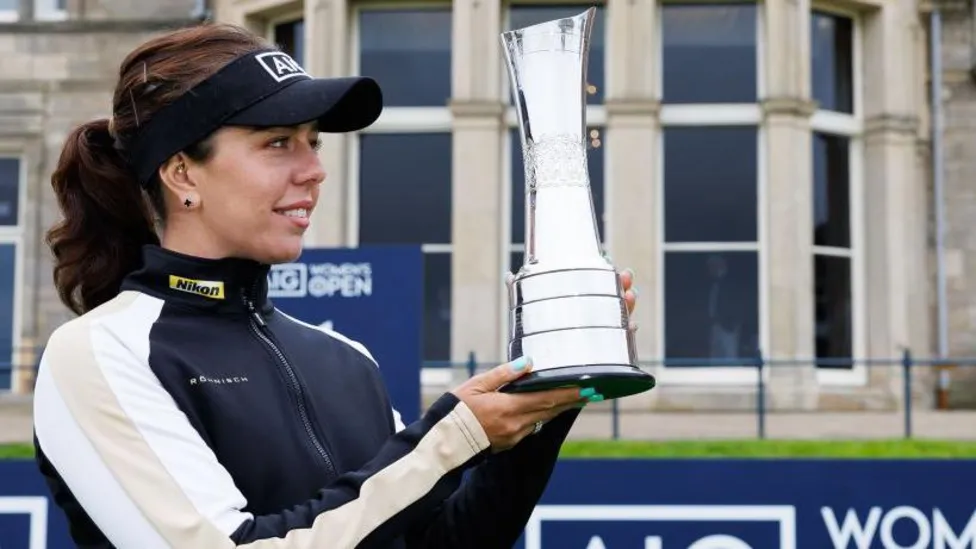Portugal's take on beef bourguignon
https://ichef.bbci.co.uk/images/ic/800xn/p0hxx46p.jpg.webp

The Azores, an archipelago of nine islands belonging to Portugal and located roughly between Europe and the US, are cow country. They're said to be home to more cattle than people, and despite being home to less than 3% of Portugal's population, the islands produce 30% of Portugal's dairy products and 13% of its beef.
Beef is part of everyday life in the Azores, and come spring on one particular island, the ingredient even crosses paths with religion.
In the days following Easter, Azorean people kick off a series of religious celebrations called Festas do Espírito Santo (Festivals of the Holy Spirit). During the 13th Century, a Catholic sect called the Cult of the Holy Spirit predicted a utopian era on Earth. This fringe faith was discouraged in mainland Europe but lived on in these remote islands in the middle of the Atlantic Ocean. The sect was also promoted by Portuguese queen Elizabeth of Aragon (also known as Elizabeth of Portugal), who was known for her charity.
Over the subsequent centuries, a series of festivals emerged on the Azores that blended these utopian aspirations with the queen's alleged generosity. Between Easter and the week following Whitsunday, a total of eight weeks, the islands host a series of parades and other cultural and religious festivals that revolve around brightly coloured community houses called impérios. During this time, the community houses also collect donations from locals, which is then redistributed to people in the form of bread, beef and wine.
These three elements generally come together in the form of a soup, called sopa do Espírito Santo, that's served at the impérios during the festivals. But on the island of Terceira, locals combine these ingredients in a different and delicious way, one that's become synonymous with the island's culinary identity.
Austin Bush The Festas do Espírito Santo revolve around community houses called impérios (Credit: Austin Bush)Austin Bush
The Festas do Espírito Santo revolve around community houses called impérios (Credit: Austin Bush)
"People eat alcatra year round, but especially during the celebrations in spring and summer," explains Duarte Fournier. He is the Grand Master of the Brotherhood of Alcatra, a culinary fraternity on Terceira, and is telling me about the island's signature dish: cuts of beef braised in local wine, smoked pork fat and dried spices, resulting in something of a heartier, spicier, richer version of France's famed boeuf bourguignon.
We're sitting at a cafe in Angra do Heroísmo, Terceira's largest city, and as we chat, children race to and from a nearby império delivering massive trays of raw beef to neighbours. Fournier tells me that alcatra likely has its origins in northern Portugal, where there's a tradition of baking goat in wine.
"We don't know why it's called alcatra," he says. "We suppose it's from Arabic. Al catar means 'small pieces of meat'."
According to Fournier, alcatra differs from mainland Portugal's baked meat dishes in that it includes dried spices, generally allspice and black peppercorns, but also sometimes clove or cinnamon.
"Spices came to Terceira on trading boats," says Fournier, referencing Portugal's expansive maritime trade network, which, from as early as the 16th Century, included points in Africa, modern-day India, China, Southeast Asia and the Americas – the origins of many of the dried spices we use today. "They would come with spices and leave with fruit."
Fournier insists that the beef for alcatra must come from grass-fed cows – standard on Terceira – and that at least one of the cuts should have a bone, both factors that contribute to the taste of the dish. He adds, "An old cow is better for alcatra. It takes longer to cook, which means it has a better flavour in the end."
With these tips and background information, I approach my friend, a chef and native of Terceira, José Sousa, to ask if he would be willing to make alcatra. Sousa works in Lisbon but was visiting home, which meant that he would be making the island's most traditional and celebrated dish not just for me, but also for his parents and grandparents – all natives of Terceira.
We start by visiting Sousa's grandmother to get the family alguidar, the tapered, hand-thrown clay vessel used to bake alcatra. After decades of use, the pot is stained a dark, almost black hue.
"The alguidar gets seasoned like a cast iron pan, and the dish comes out even better," Sousa says, adding that the alguidar is something of a family heirloom that gets passed down generation to generation.
Sousa's father had already received beef from an império, so we continue around Angra do Heroísmo on foot in search of the remaining ingredients. At Bertílio Simões & Irmãos, a grocery store that dates to 1860, we stop for dried spices.
“Our recipe for alcatra uses allspice,” says Maria Serafina Simões, the shop’s fourth-generation owner, handing us a photocopy of her family's recipe. “Cloves aren’t necessary. In other parts of the island, they use cinnamon.”
We walk away with black pepper and allspice, obligatory in the Sousa family recipe, and head off in search of wine. Purists like Fournier insist on using only white wine, specifically that made from verdelho grapes on Terceira or nearby Pico Island, but Sousa uses a combination of local verdelho and vinho de cheiro (red table wine from the Azores).
"Historically verdelho, a white Azorean wine, was the only 'proper' wine for the production of alcatra," says Sousa. "But due to its price, it was reserved for the richer classes. Humbler people would use vinho de cheiro, a very aromatic and light red made with Isabelle grapes. In my opinion, the perfect combination of acidity, aroma, colour and richness of an alcatra is achieved with a mixture of both these wines – just like my father taught me how to make it."
At this point, it is getting late and Sousa isn't sure we'll have enough time for the low, slow braise required to make alcatra the traditional way, which takes at least eight hours. So, dipping into his reserve of chef's tricks, he improvises a "fast" method in which he sears the beef and simmers it in water and wine until tender before layering it with the other ingredients and baking them in the alguidar.
After around three hours in the oven, Sousa removes the foil from the top of the alguidar and the ingredients are bubbling, the aroma of beef, wine and spices filling his parents' apartment. He adds a pat of butter – another ubiquitous Azorean ingredient – and after another hour in the oven, the surface of the dish is pleasantly browned and coated by an appetising layer of fat. Sousa serves the stew over thin slices of massa sovada, a sweet bread also associated with the island, and the result is fall-apart tender, rich and pleasantly salty. I find it utterly delicious, but more importantly, the alcatra passes muster with Sousa's family, who share that they "wouldn't change anything" about the dish.
Serves 8
Traditionally, alcatra was baked in wood-burning ovens overnight. The following is a slightly expedited version of the dish, in which the cuts of beef are pan-seared then boiled until tender before being oven braised for around four hours.
If you don't have an alguidar, the clay pot used to make alcatra on Terceira, a cast iron cassoulet pot will do.
Ingredients:
2 tbsp (30ml) vegetable oil
60g lard
2kg beef shoulder with a bit of fat, cut into 8cm x 3cm pieces
1kg bone-in beef shank, around 3cm thick
1 cup light red wine (ideally vinho de cheiro from the Azores)
1 cup + ½ cup white wine (ideally vinho verdelho from the Azores)
½ cup water
20g salt
3 onions, peeled and diced
1 head garlic, peeled and sliced thinly
150g smoked pork fat (toucinho), diced
10 cloves
1 heaping tsp (4g) allspice
2 bay leaves
2 tbsp (30g) butter
Method
Step 1
Heat the vegetable oil and 1 tbsp (15g) of the lard in a cassoulet pot over high heat. Sear all the cuts of beef in portions, removing and setting aside. Return all the beef to the pot, add the red wine, white wine, water and salt, bring to the boil, then reduce heat, cover and rapidly simmer until the beef is just starting to get tender when pierced with a knife, around 30 minutes. Remove from heat, put the beef and the liquid into separate bowls and reserve.
Step 2
Preheat an oven to 180C. Coat the interior of the alguidar (or cassoulet pot) with the remaining lard. To the bottom, add half the onions and half the garlic. Top with around half the reserved beef, half the smoked pork, half the cloves, half the allspice, half the bay leaves and a generous sprinkle of salt. Repeat with the remaining ingredients. Add the reserved liquid. If it's not enough to come just short of the level of the beef, add a mix of equal parts red and white wine to that level. Cover the alguidar with foil (or cover the cassoulet with its lid) and bake for three hours.
Step 3
After around three hours, remove the foil (or lid); the dish should be bubbling, the liquid should have reduced slightly and the exposed top layer should be slightly dry. The fragrance will have shifted from cooking wine/alcohol to rich aroma of melting fat and the dried spices. Increase the heat to 220C, add the butter and bake, uncovered, for another hour, until the exposed layer is pleasantly browned, and the beef is fall-apart tender.
-bbc







